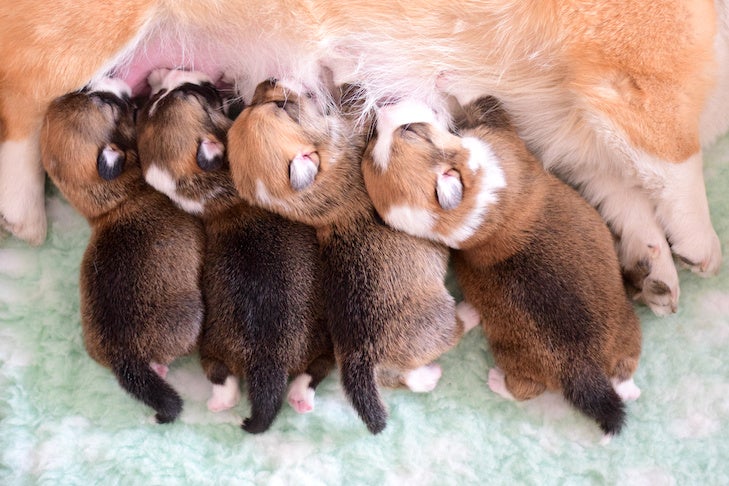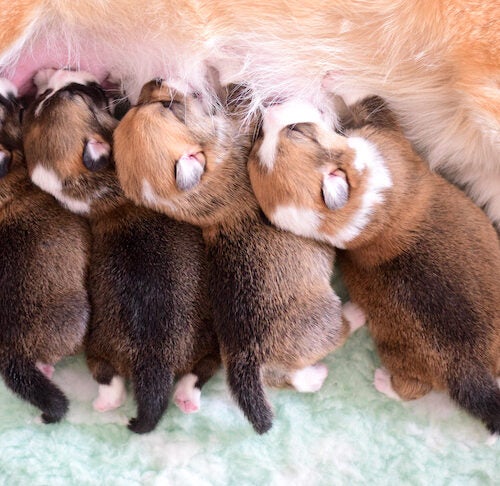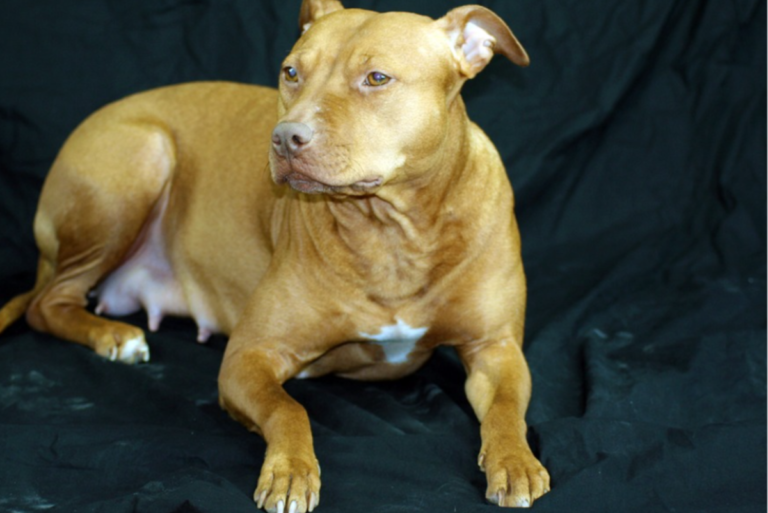When a dog is in labor, you can tell by signs such as restlessness, contractions, a drop in temperature, lack of appetite, vomiting, nesting behavior, panting, shivering, and licking the genitals. These behaviors indicate that the dog is preparing to give birth to her puppies.
It is important to observe these signs and provide a comfortable and safe environment for the dog to deliver her puppies.

Credit: www.telegram.com
Understanding Labor Stages In Dogs
Before discussing the stages of labor in dogs, it’s important to understand the signs that indicate labor is approaching. During stage one, you may notice several early signs of labor in your dog:
- Restlessness
- Contractions
- Temperature drop
- Lack of appetite
- Vomiting
- Nesting
These signs typically indicate that labor will begin in the next 24-48 hours. Your dog may exhibit restlessness, pacing, and refusal of food. She may also start nesting, showing a strong desire to create a comfortable space for labor and delivery.
Once stage two begins, active labor is underway. Your dog will exhibit more obvious signs of labor, including:
- Panting
- Shivering
- Licking the genitals
During this stage, your dog will start to have strong, visible contractions as she prepares to give birth to her puppies. It’s important to keep a close eye on her during this time to ensure she delivers safely.
After the puppies are born, stage three begins, which involves the expulsion of the placenta or afterbirth. During this stage, your dog may continue to have contractions as she delivers the placentas.
It’s important to note that the number of placentas should match the number of puppies delivered. If your dog doesn’t expel all the placentas or if there are more placentas than puppies, contact your veterinarian immediately.

Credit: www.akc.org
Signs And Symptoms Of Labor In Dogs
When it comes to ensuring the wellbeing of your beloved dog during labor, it is essential to know the signs and symptoms to look out for. By being aware of these indicators, you can better prepare yourself and provide appropriate care. Here are some of the key signs and symptoms of labor in dogs:
Drop In Temperature
A drop in temperature is one of the early signs that your dog is entering labor. Typically, a dog’s normal temperature ranges between 101 and 102.5 degrees Fahrenheit. However, a day or two before delivery, her body temperature may drop to around 98-99 degrees Fahrenheit. This drop in temperature indicates that labor is imminent, and you should promptly prepare for the arrival of the puppies.
Restlessness And Anxiety
After the temperature drop, the first stage of labor, known as stage I, begins. It is characterized by restlessness and anxiety in your dog. She may exhibit signs such as panting, pacing, and refusing food. You might also notice episodes of vomiting. It is crucial to create a comfortable and familiar environment, placing her in the whelping box where she can feel secure and calm.
Changes In Nesting Behavior
During labor, your dog’s nesting behavior will become more apparent. This includes her seeking out soft and safe spaces to make her birthing area. Ensure that the whelping box is suitably prepared in advance with clean bedding and is easily accessible for her. Familiarity with the box will contribute to her comfort and ease during the birthing process.
Loss Of Appetite
A loss of appetite is common during labor in dogs. As the body focuses on the birthing process, your dog may refuse to eat. It is normal for her to experience a temporary decrease in appetite. However, if you notice a prolonged loss of appetite or if she appears overly lethargic, it is important to consult with a veterinarian.
Vomiting
During labor, some dogs may experience episodes of vomiting. This is typically due to the stress and physical exertion associated with the birthing process. If your dog vomits, ensure she has access to fresh water to prevent dehydration. However, if vomiting persists or is accompanied by other concerning symptoms, seek veterinary assistance.
Shivering
Shivering can be another indication that your dog is in labor. As the body adjusts to the changes occurring during labor, it may react by shivering. This is a natural response and usually subsides once the puppies have been delivered.
Panting
Just like humans, dogs may pant during labor. Panting helps to regulate body temperature and is often a sign of discomfort. Your dog may pant heavily as labor progresses, and this is normal. Provide a calm and quiet environment to help her relax and facilitate the labor process.
Tiredness
With the physical toll of labor and delivery, your dog will likely feel tired. As each puppy is born, your dog’s energy levels may decrease. Allow her time to rest and recover between each delivery. It is essential to monitor her closely throughout the process to ensure a safe and healthy labor.
What To Do During Labor And Delivery
During labor and delivery, there are several signs to look for to determine if a dog is in labor. These include restlessness, contractions, a drop in body temperature, lack of appetite, vomiting, nesting behavior, panting, shivering, and licking the genitals.
During the labor and delivery process, it’s essential to be prepared and attentive to ensure a smooth and safe experience for both the mother dog and her puppies. Here are the steps to follow during this crucial time:Preparing For Delivery
Before the mother dog goes into labor, it’s crucial to create a comfortable and safe whelping environment. Some essential preparations include:- Setting up a spacious whelping box, lined with clean blankets or towels, to provide a cozy and warm space for the mother and her puppies.
- Gathering necessary supplies, such as clean towels, sterile scissors, dental floss or thread for tying umbilical cords, and a heating pad or heat lamp to maintain a consistent temperature.
- Ensuring access to fresh water and easily digestible food for the mother during and after labor.
Monitoring The Dog’s Progress
It’s crucial to closely monitor the mother dog’s progress during labor. Some signs to watch out for include:- Panting and restlessness
- Increased licking of the genitals
- Visibly contracting and heaving abdomen
- Straining and pushing
Supporting The Dog During Labor
During labor, it’s essential to be a calming presence for the mother dog. Here are some ways to provide support:- Offering gentle reassurance through soothing words and strokes, helping to keep the mother dog relaxed.
- Ensuring a quiet and stress-free environment by minimizing external noises and disturbances.
- Maintaining a comfortable temperature in the whelping area to keep the mother and her puppies warm.
Assisting With Puppy Delivery
In some cases, the mother dog may require assistance during the delivery process. If you notice any signs of distress or prolonged labor, it’s time to step in. Remember to:- Wash your hands thoroughly and put on sterile gloves to prevent infections.
- Gently break the amniotic sac if necessary, using scissors sterilized with alcohol.
- Help guide the puppies out if the mother is struggling, but be careful not to pull too forcefully.
- Tie off the umbilical cord about an inch from the puppy’s belly using dental floss or thread and cut it about an inch further.
- Use a clean towel to stimulate each puppy’s breathing by gently rubbing them.
Aftercare For The Dog And Puppies
Once all the puppies are delivered, it’s crucial to provide proper aftercare for both the mother dog and her newborns. Here are a few essential steps:- Allow the mother dog to rest and bond with her puppies in a calm and quiet environment.
- Observe the puppies for signs of nursing, warmth, and vitality. Ensure each puppy successfully latches onto the mother’s nipples for feeding.
- Clean up the whelping area by removing soiled bedding and replacing it with fresh, clean materials.
- Monitor the mother dog closely for any signs of postpartum complications, such as excessive bleeding, fever, or loss of appetite. Contact your veterinarian if you notice any concerning symptoms.

Credit: www.akc.org
Frequently Asked Questions On How To Tell When A Dog Is In Labor
How Do Dogs Act When Labor Is Near?
As labor approaches, dogs may show signs of restlessness, contractions, a drop in temperature, lack of appetite, vomiting, nesting behavior, panting, shivering, and licking the genitals.
What Are The Signs Of A Dog Going Into Labor?
Signs of a dog going into labor include restlessness, contractions, temperature drop, lack of appetite, vomiting, nesting, panting, shivering, and licking the genitals.
How Long Does The First Stage Of Dog Labor Last?
The first stage of dog labor typically lasts for a few hours or up to 24 hours. During this stage, you may notice restlessness, panting, pacing, refusal of food, and possibly vomiting. The dog may also exhibit nesting behavior. It is a good time to place her in the whelping box.
How Do I Know If My Dog Still Has Puppies Inside Her?
To know if your dog still has puppies inside her, look for signs such as restlessness, contractions, a drop in temperature, lack of appetite, vomiting, nesting behavior, panting, shivering, and licking of the genitals. Keep an eye on her behavior and consult with a veterinarian if you have concerns.
Conclusion
Recognizing the signs of labor in dogs is crucial for ensuring a smooth and successful delivery. Look out for restlessness, contractions, a temperature drop, lack of appetite, vomiting, nesting behavior, panting, shivering, and licking the genitals. Paying attention to these indicators will help you prepare for and assist your dog during this important time.
Remember to consult with your veterinarian for any concerns or questions regarding your dog’s pregnancy and labor.



